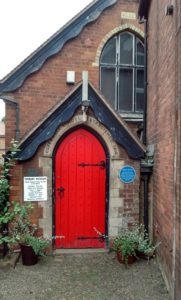In a previous post I reported on a research visit to the Corinium Museum, Cirencester, which was generously facilitated by a small grant from the UK Numismatic Trust. Funding from the UKNT has also allowed me to pursue other research visits to regional archives and museums, and on this basis I visited Tenbury Museum in July 2017 to examine their token collection.
Situated in the northwest of the county on the Shropshire border, Tenbury is probably the smallest of Worcestershire’s ‘small towns’, with just under 3000 inhabitants at the time of the 2001 census – roughly three times the population of the seventeenth century parish, if the evidence of the hearth tax returns of 1664/5 and 1676 ecclesiastical census can be trusted. It lies in the heart of the picturesque Teme Valley, whose undulating topography is a mosaic of rich red cultivated soils, hilly pasture flocked by cattle and sheep, and stretches of ancient woodland interspersed with scattered farmsteads and small villages. Much of this setting was familiar to early modern visitors; according to the late sixteenth century antiquary William Camden, the region possessed ‘rich meadows, and the soil on both sides [of the Teme] produceth excellent Syder, and Hops in great abundance’, while two centuries later the topographer James Baker would note Tenbury’s ‘rich and spacious’ countryside, and how ‘in summer…none exhibits on its bounds larger or more varied successions of productive plantations of grain, cyder-fruit and hops’. A walk through the town takes barely any time, and gives some stunning glimpses of its medieval and early modern inheritance.

The Kings Head Pub, Cross Street – one of several surviving early modern buildings in Tenbury
Since 1977 Tenbury has had its own local museum, run by an active and enthusiastic team of volunteers from the Tenbury Wells Museum and History Group. After a speculative enquiry in the spring I quickly discovered that the museum held a small collection of seventeenth century tokens, and after some email correspondence with the group secretary, Mike Thompson, a research visit was arranged for the summer.

Tenbury Museum in Goff’s Free School
On arrival in Tenbury I met up with Mike, who kindly showed me around the stunning Tenbury Pump Rooms, a Grade II* listed mid-nineteenth century bath house built to promote the town as a Victorian working class spa destination. The Museum Group organises tours of the Pump Rooms on a monthly basis, and I’d strongly recommend a visit! Following this trip we headed towards the museum, which presently occupies a Free School built in 1819 on the bequest of the Hereford-born coal merchant Edward Goff. The building is attractive, but very small – although this is certainly part of its charm.
The numismatic collection at Tenbury Museum is similarly modest, as is its Worcestershire token element – just three specimens. Size isn’t everything, however, and from the perspective of the Project these objects represent a very welcome body of evidence indeed. One specimen is a civic halfpenny of the Wardens of Bewdley, issued in 1668 (Cotton 3); its reverse motif, an anchor flanked by a sword and a rose, is the same design as that used on the town’s common seal. The remaining two specimens are both private issues: one a 1667 halfpenny of Thomas Balamey of Kidderminster (Cotton 40), and the other a 1662 halfpenny of William Swift of Worcester (Cotton 107). Balamey’s profession is indicated by the presence of the Weavers arms on the obverse of his token, and extracts from his 1691 probate inventory published by Cotton illuminate the nature of his business: his ‘stock in trade’ included eight looms, large quantities of wool and linen yarn, and other tools of the trade. It also informs us of the standards of living a successful weaver might maintain at this date, which included a well-furnished house and personal estate worth £206 6s. 9d.
Swift’s token, by contrast, chose to depict the three pears of Worcester, leaving few numismatic clues as to his profession. The Swifts were a prominent family in seventeenth century Worcester, with one member, Samuel Swift, being elected to the mayoralty in 1684; the named William Swift can probably be identified with the 57 year old ‘merchant and sugar baker, grocer and draper’ recorded in the county visitation of 1682-3 , who had previously served as the county’s high sheriff in 1675, and whose burial is recorded in the parish registers of Worcester St Swithun under 20 February 1688.
From a numismatic perspective the specimens in Tenbury Museum have some interesting features. The halfpenny of William Swift, for example, was struck using a pair of dies observed on another specimen that I have recorded; however, the Tenbury specimen lacks a die crack present on that specimen, so must have been produced before it. This sort of information is really useful for building up a high-resolution chronology of token production, so was a real treat to discover! Both other specimens are also struck from dies recorded in other museum collections – in these cases, the phenomenal nineteenth century collection formed by William Alfred Cotton held at Worcester City Art Gallery and Museum.
I’m really grateful to Mike Thompson and the team at Tenbury Museum for facilitating this research, and to the UK Numismatic Trust for providing the funding that made it happen.
Murray Andrews
